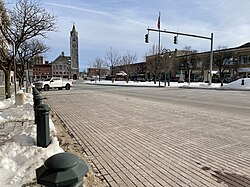Public Square (Watertown, New York)
United States historic place From Wikipedia, the free encyclopedia
United States historic place From Wikipedia, the free encyclopedia
The Public Square Historic District is a historic district that serves as an open mall in the center of Watertown, New York, containing 58 buildings, one contributing site, and three contributing objects. The district was listed on the National Register of Historic Places on September 7, 1984.[1]
Public Square Historic District | |
 Public Square in January 2022. | |
| Location | Roughly Court, Arsenal, Washington, Franklin and State Sts., Watertown, New York |
|---|---|
| Coordinates | 43°58′29″N 75°54′34″W |
| Area | 16 acres (6.5 ha) |
| Built | 1805 |
| Architect | Augustus Saint-Gaudens; Multiple |
| Architectural style | Late 19th And 20th Century Revivals, Late Victorian, Art Deco |
| NRHP reference No. | 84002409[1] (original) 16000110 (increase) |
| Significant dates | |
| Added to NRHP | September 7, 1984 |
| Boundary increase | March 22, 2016 |

The square is rectangular in shape. Buildings line all four sides of the square, while a large oval park sits in its center. A one-way traffic pattern circles the park. Seven of Watertown's main streets (including U.S. Route 11, New York State Route 3, New York State Route 12, and New York State Route 283) intersect at the square, making it a heavy traffic destination for motorists.
While the square boasts some modern architecture, its main character is defined by the numerous 19th- and early 20th-century buildings that still stand. Throughout its buildings, the square is host to a multitude of shops, restaurants, business offices, churches and apartment houses, making it a major shopping and business destination in the city.

Watertown's first settlers built their homesteads on what is now the square's West End in 1800. In 1805, several settlers donated land for public use which became the basis of the square. This helped to develop the square as Watertown's main business district. The current layout of the square and its surrounding streets developed in those early years.[2][3]
On May 13, 1849, a fire started inside the American Hotel, killing one. Most of Public Square and buildings on three adjacent streets were destroyed.[4] The fire destroyed nearly all of the business portion of the city, including three banks, post office, three printing offices, two hotels, and thirty stores.[5] The square was immediately rebuilt for $250,000 (Now $9,156,000).[6] Several buildings erected during the rebuilding still stand. In the rebuilding of the 1850s, the city created three parks at the square's center, with a fountain inside the center park. During Watertown's industrial boom in the late 19th and early 20th centuries, Public Square became the heart of Watertown's retail, business and social life. In the 1950s, the three parks in the square's center were combined into one large park.
The Soldiers and Sailors Monument was added in 1891.[7]

The square's retail and business dominance started declining in the latter half of the 20th century. Urban renewal policies during the 1960s and 1970s resulted in the demolition of some of the square's historic structures. Declining industry hurt Watertown's once prospering economy. Although nearby the Fort Drum military reservation expanded in the 1980s and brought growth to the Watertown, modern shopping malls and retail chains built on the city's west side drew business away from the square. Public Square's days as the city's main retail destination were at an end. The square continued its slow decline over the next 20 years.[8]

The beginning of the 21st century saw a reversal in attitudes towards Public Square. With a resurgence of pride in the square and its role in Watertown's history, civic and business leaders have taken a strong role in its redevelopment. Existing buildings were refurbished and new businesses moved in. Some decaying structures beyond repair were demolished. In 2006, the new economic development was coupled with a multimillion-dollar streetscape project to reinforce the square's infrastructure, as well as beautify its roads, walkways and landscaping. This project was completed in November, 2008.[9]

Public Square has been the site of many notable people, buildings and inventions.
Seamless Wikipedia browsing. On steroids.
Every time you click a link to Wikipedia, Wiktionary or Wikiquote in your browser's search results, it will show the modern Wikiwand interface.
Wikiwand extension is a five stars, simple, with minimum permission required to keep your browsing private, safe and transparent.